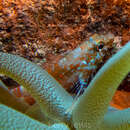en
names in breadcrumbs


Diagnosis: A modal fin ray count of D-XII,13 A-II,15 pect 14 indicates Hypleurochilus spp. and Lupinoblennius vinctus. L. vinctus has a gill slit continuous around the isthmus, separating it from the Hypleurochilus spp. and Hypsoblennius spp. who have restricted gill slits. There are six regional Hypleurochilus spp. (sensu Williams in the FAO book), but only two are widespread in the Caribbean: H. springeri and H. pseudoaequipinnus (= Caribbean H. aequipinnus). Their modal fin ray counts are the same, but the latter can often have 14 dorsal fin soft rays and 16 anal fin soft rays. H. bermudensis shares the modal fin ray count but is found in Bermuda, Bahamas, Florida and the Gulf of Mexico only. The remaining Hypleurochilus spp. are found in continental US waters only and have more medial fin rays: H. multifilis and H. caudovittatus with 14-15 dorsal fin soft rays and 16-17 anal fin soft rays and H. geminatus with 14-15 dorsal fin soft rays and 17-18 anal fin soft rays.